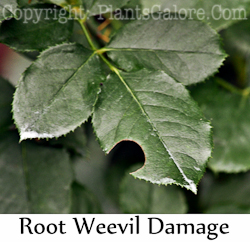 Root weevils can be
serious pests of berry plants, ornamentals and
certain grasses. They do their damage in both the
adult and immature larvae form. As with all weevils,
the adult beetles have a pronounced snout and
chewing mouth parts. Their shells are either light
brown to black and they have rows of depressions
along their backs.
Root weevils can be
serious pests of berry plants, ornamentals and
certain grasses. They do their damage in both the
adult and immature larvae form. As with all weevils,
the adult beetles have a pronounced snout and
chewing mouth parts. Their shells are either light
brown to black and they have rows of depressions
along their backs.
Most species of root
weevils do not fly since their wing covers are fused
together on their backs. The adult weevils feed at
night and generally leave notches on the edges of
the leaves.
The larvae are a
white, C-shaped grub that is legless and has a brown
colored head. They often feed at the base of the
plant stem and may also burrow into the root zone.
The grubs spend the winter in the soil and start to
feed again in the spring. In large infestations,
they may do enough damage to the root system to
cause the plant to lose vigor and be severely
weakened.



